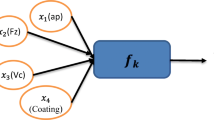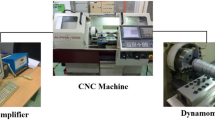Abstract
In this article, the adaptive neuro-based fuzzy inference system (ANFIS) model is developed to estimate the surface roughness (Ra) and tool vibrations (Acc) of AA6013 aluminum alloy during dry turning. Turning experiments were carried out with seven different cutting speeds, five different feed rates and seven different depth of cuts. These three different cutting parameters were tested with each other in different variations. ANFIS model is optimized using the genetic algorithm (GA), particle swarm optimization (PSO) and ant colony optimization. Performance of the developed model is compared with that of multi-linear regression model, which is one of the conventional prediction approaches. At the end of the study, it is revealed that the GA-ANFIS with an R-value of 0.946 is seen as the best model among the proposed approaches in the estimation of Acc. The PSO-ANFIS with an R-value of 0.916 is seen as the best model among the proposed approaches in the estimation of Ra. GA-ANFIS model for Acc prediction and PSO-ANFIS model for Ra prediction are the best approaches among the models discussed in the study. Moreover, the relationship between Acc and Ra values was examined and an empirical model was proposed.

















Similar content being viewed by others
References
Abbas A, Pimenov D, Erdakov I et al (2018) Artificial intelligence monitoring of hardening methods and cutting conditions and their effects on surface roughness, performance, and finish turning costs of solid-state recycled aluminum alloy 6061 chips. Metals 8:394. https://doi.org/10.3390/met8060394
Aghdeab SH, Mohammed LA, Ubaid AM (2015) Optimization of CNC turning for aluminum alloy using simulated annealing method. Jordan J Mech Indust Eng 9:39–44
Birol Y, Gokcil E, Guvenc MA, Akdi S (2016) Processing of high strength EN AW 6082 forgings without a solution heat treatment. Mater Sci Eng A 674:25–32. https://doi.org/10.1016/j.msea.2016.07.062
Ubaid M, Bajaj D, Mukhopadhyay AK, Siddiquee AN (2019) Friction stir welding of thick AA2519 alloy: defect elimination, mechanical and micro-structural characterization. Met Mater Int. https://doi.org/10.1007/s12540-019-00472-3
Sahoo P, Pratap A, Bandyopadhyay A (2017) Modeling and optimization of surface roughness and tool vibration in CNC turning of aluminum alloy using hybrid RSM-WPCA methodology. Int J Ind Eng Comput 8:385–398. https://doi.org/10.5267/j.ijiec.2016.11.003
Arriaza OV, Tumurkhuyagc Z, Kim D-W (2018) Chatter identification using multiple sensors and multi-layer neural networks. Procedia Manuf 17:150–157. https://doi.org/10.1016/J.PROMFG.2018.10.030
Guvenc MA, Huseyin Bilgic H, Mistikoglu S (2021) Identification of chatter vibrations and active vibration control by using the sliding mode controller on dry turning of titanium alloy (Ti6Al4V). FACTA UNIVERSITATIS Series, Mechanical Engineering, pp 1–16
Urbikain G, de Lacalle LNL (2018) Modelling of surface roughness in inclined milling operations with circle-segment end mills. Simul Model Pract Theory 84:161–176. https://doi.org/10.1016/j.simpat.2018.02.003
Munoa J, Beudaert X, Dombovari Z et al (2016) Chatter suppression techniques in metal cutting. CIRP Ann Manuf Technol 65:785–808. https://doi.org/10.1016/j.cirp.2016.06.004
Dos Santos HFL, Trindade MA (2011) Structural vibration control using extension and shear active-passive piezoelectric networks including sensitivity to electrical uncertainties. J Braz Soc Mech Sci Eng 33:287–301. https://doi.org/10.1590/s1678-58782011000300004
Trindade MA (2007) Simultaneous extension and shear piezoelectric actuation for active vibration control of sandwich beams. J Intell Mater Syst Struct 18:591–600. https://doi.org/10.1177/1045389X06076592
Abbas AT, Alata M, Ragab AE et al (2017) Prediction model of cutting parameters for turning high strength steel Grade-H: comparative study of regression model versus ANFIS. Adv Mater Sci Eng. https://doi.org/10.1155/2017/2759020
Kim DH, Kim TJY, Wang X et al (2018) Smart machining process using machine learning: a review and perspective on machining industry. Int J Precis Eng Manuf Green Technol 5:555–568. https://doi.org/10.1007/s40684-018-0057-y
Grzesik W (2017) Cutting vibrations. Adv Mach Process Metal Mater. https://doi.org/10.1016/B978-0-444-63711-6.00008-9
Kakinuma Y, Enomoto K, Hirano T, Ohnishi K (2014) Active chatter suppression in turning by band-limited force control. CIRP Ann Manuf Technol 63:365–368. https://doi.org/10.1016/j.cirp.2014.03.136
Garcia LA, Trindade MA (2019) Finite element modeling and parametric analysis of a dielectric elastomer thin-walled cylindrical actuator. J Braz Soc Mech Sci Eng 41:1–9. https://doi.org/10.1007/s40430-018-1527-4
Seyed Muhammad Hossein M, Younes MS, Vyacheslav L (2017) An evolutionary-based adaptive neuro-fuzzy expert system as a family counselor before marriage with the aim of divorce rate reduction. In: Conference: 2nd international conference on research knowledge base in computer engineering and IT 1–10
Alajmi MS, Almeshal AM (2020) Prediction and optimization of surface roughness in a turning process using the ANFIS-QPSO method. Materials 13:1–23. https://doi.org/10.3390/ma13132986
Jain V, Raj T (2018) Prediction of cutting force by using ANFIS. Int J Syst Assur Eng Manag 9:1137–1146. https://doi.org/10.1007/s13198-018-0717-x
Bilgic HH, Guvenc MA, Cakir M, Mistikoglu S (2019) A study on prediction of surface roughness and cutting tool temperature after turning for S235JR steel. Konya J Eng Sci 7:966–974. https://doi.org/10.36306/konjes.624725
Mohd Adnan MRH, Sarkheyli A, Mohd Zain A, Haron H (2013) Fuzzy logic for modeling machining process: a review. Artif Intell Rev 43:345–379. https://doi.org/10.1007/s10462-012-9381-8
Srinivasa Pai P, D’Mello G (2015) Vibration signal analysis for monitoring tool wear in high speed turning of Ti-6Al-4V. Indian J Eng Mater Sci 22:652–660
Koyee RD, Heisel U, Eisseler R, Schmauder S (2014) Modeling and optimization of turning duplex stainless steels. J Manuf Process 16:451–467. https://doi.org/10.1016/j.jmapro.2014.05.004
Upase R, Ambhore N (2020) Experimental investigation of tool wear using vibration signals: an ANN approach. Mater Today: Proc 24:1365–1375. https://doi.org/10.1016/j.matpr.2020.04.454
Shivakoti I, Kibria G, Pradhan PM et al (2019) ANFIS based prediction and parametric analysis during turning operation of stainless steel 202. Mater Manuf Process 34:112–121. https://doi.org/10.1080/10426914.2018.1512134
Thamizhmanii S, Saparudin S, Hasan S (2007) Analyses of surface roughness by turning process using Taguchi method. J Achiev Mater Manuf Eng 20:503–505
Deshpande YV, Andhare AB, Padole PM (2019) Application of ANN to estimate surface roughness using cutting parameters, force, sound and vibration in turning of Inconel 718. SN Appl Sci 1:1–9. https://doi.org/10.1007/s42452-018-0098-4
Lmalghan R, Rao K, ArunKumar S et al (2018) Machining parameters optimization of AA6061 using response surface methodology and particle swarm optimization. Int J Precis Eng Manuf 19:695–704. https://doi.org/10.1007/s12541-018-0083-2
Singh D, Rao PV (2007) A surface roughness prediction model for hard turning process. Int J Adv Manuf Technol 32:1115–1124. https://doi.org/10.1007/s00170-006-0429-2
Güvenç MA, Çakır M, Mıstıkoğlu S (2019) Experimental study on optimization of cutting parameters by using taguchi method for tool vibration and surface roughness in dry turning of AA6013. In: Proceedings of 10th international symposium on intelligent manufacturing and service systems, pp 1032–1040
Siddhpura M, Paurobally R (2012) A review of chatter vibration research in turning. Int J Mach Tools Manuf 61:27–47. https://doi.org/10.1016/j.ijmachtools.2012.05.007
Ambhore N, Kamble D, Chinchanikar S (2020) Evaluation of cutting tool vibration and surface roughness in hard turning of AISI 52100 steel: an experimental and ANN approach. J Vib Eng Technol 8:455–462. https://doi.org/10.1007/s42417-019-00136-x
Bhuiyan MSH, Choudhury IA (2015) Investigation of tool wear and surface finish by analyzing vibration signals in turning ASSAB-705 steel. Mach Sci Technol 19:236–261. https://doi.org/10.1080/10910344.2015.1018531
Naresh C, Bose PSC, Suryaprakash Rao C, Selvaraj N (2020) Prediction of cutting force of AISI 304 stainless steel during laser-assisted turning process using ANFIS. Mater Today: Proc 38:2366–2371. https://doi.org/10.1016/j.matpr.2020.07.074
Bilgic HH, Mert I (2021) Comparison of different techniques for estimation of incoming longwave radiation. Int J Environ Sci Technol 18:601–618. https://doi.org/10.1007/s13762-020-02923-6
Jang J (1991) Fuzzy modeling using generalized neural networks and kalman filter algorithm. In: Proceedings of the 9th National Conference on Artificial Intelligence 91:762–767
Paul SK, Azeem A, Ghosh AK (2015) Application of adaptive neuro-fuzzy inference system and artificial neural network in inventory level forecasting. Int J Bus Inform Syst 18:268–284. https://doi.org/10.1504/IJBIS.2015.068164
Fidanova S (2021) Ant colony optimization. Stud Comput Intell 947:3–8. https://doi.org/10.1007/978-3-030-67380-2_2
Çakır M, Oral M, Aydın A (2011) Karınca Koloni Optimizasyon Algoritmaları ile Risk Faktörlerine Bağlı Optimum Hastane Yerleşim Noktasının Bulunması. Eng Sci 6:195–208. https://doi.org/10.12739/nwsaes.v6i1.5000067023
Akdagli AA, Guney K, Karaboga D (2006) Touring ant colony optimization algorithm for shaped-beam pattern synthesis of linear antenna. Electromagnetics 26:615–628. https://doi.org/10.1080/02726340600978349
Eren B, Guvenc MA, Mistikoglu S (2020) Artificial intelligence applications for friction stir welding: a review. Met Mater Int. https://doi.org/10.1007/s12540-020-00854-y
Wahid MA, Masood S, Khan ZA et al (2019) A simulation-based study on the effect of underwater friction stir welding process parameters using different evolutionary optimization algorithms. Proc Inst Mech Eng C J Mech Eng Sci 234:643–657. https://doi.org/10.1177/0954406219883904
Eberhart R, Kennedy J (1995) New optimizer using particle swarm theory. Proceedings of the international symposium on micro machine and human science. https://doi.org/10.1109/mhs.1995.494215
Panda A, Sahoo AK, Panigrahi I, Rout AK (2020) Prediction models for on-line cutting tool and machined surface condition monitoring during hard turning considering vibration signal. Mech Ind. https://doi.org/10.1051/meca/2020067
Khademi F, Akbari M, Jamal SM, Nikoo M (2017) Multiple linear regression, artificial neural network, and fuzzy logic prediction of 28 days compressive strength of concrete. Front Struct Civ Eng 11:90–99. https://doi.org/10.1007/s11709-016-0363-9
Sevim UK, Bilgic HH, Cansiz OF et al (2021) Compressive strength prediction models for cementitious composites with fly ash using machine learning techniques. Constr Build Mater 271:121584. https://doi.org/10.1016/j.conbuildmat.2020.121584
Yang H, Hasanipanah M, Tahir MM, Bui DT (2020) Intelligent prediction of blasting-induced ground vibration using ANFIS optimized by GA and PSO. Nat Resour Res 29:739–750. https://doi.org/10.1007/s11053-019-09515-3
Mert İ, Bilgic HH, Yağlı H, Koç Y (2020) Deep neural network approach to estimation of power production for an organic Rankine cycle system. J Braz Soc Mech Sci Eng. https://doi.org/10.1007/s40430-020-02701-y
Chapra SC, Canale RP (2011) Numerical methods for engineers, vol 2. McGraw-Hill, New York
Acknowledgements
This work was supported by the Iskenderun Technical University scope of PhD Thesis of Mehmet Ali GUVENC. We would like to thank Iskenderun Technical University, Faculty of Engineering and Natural Sciences, for their support. Finally, we would like to thank Konya Technical University and Prof. Dr. Mete Kalyoncu for allowing us to use the laboratory facilities.
Author information
Authors and Affiliations
Corresponding author
Additional information
Technical Editor: Marcelo Areias Trindade.
Publisher's Note
Springer Nature remains neutral with regard to jurisdictional claims in published maps and institutional affiliations.
Rights and permissions
Springer Nature or its licensor holds exclusive rights to this article under a publishing agreement with the author(s) or other rightsholder(s); author self-archiving of the accepted manuscript version of this article is solely governed by the terms of such publishing agreement and applicable law.
About this article
Cite this article
Guvenc, M.A., Bilgic, H.H., Cakir, M. et al. The prediction of surface roughness and tool vibration by using metaheuristic-based ANFIS during dry turning of Al alloy (AA6013). J Braz. Soc. Mech. Sci. Eng. 44, 474 (2022). https://doi.org/10.1007/s40430-022-03798-z
Received:
Accepted:
Published:
DOI: https://doi.org/10.1007/s40430-022-03798-z




